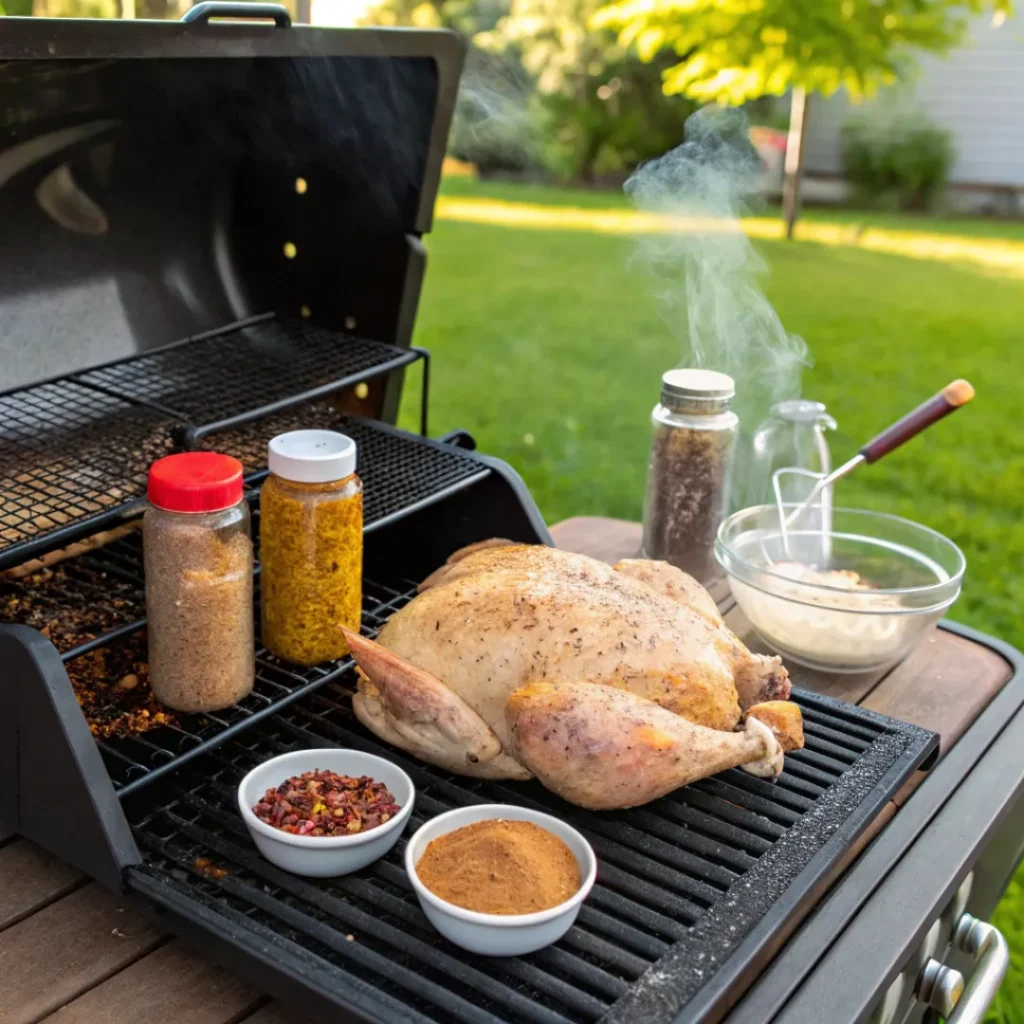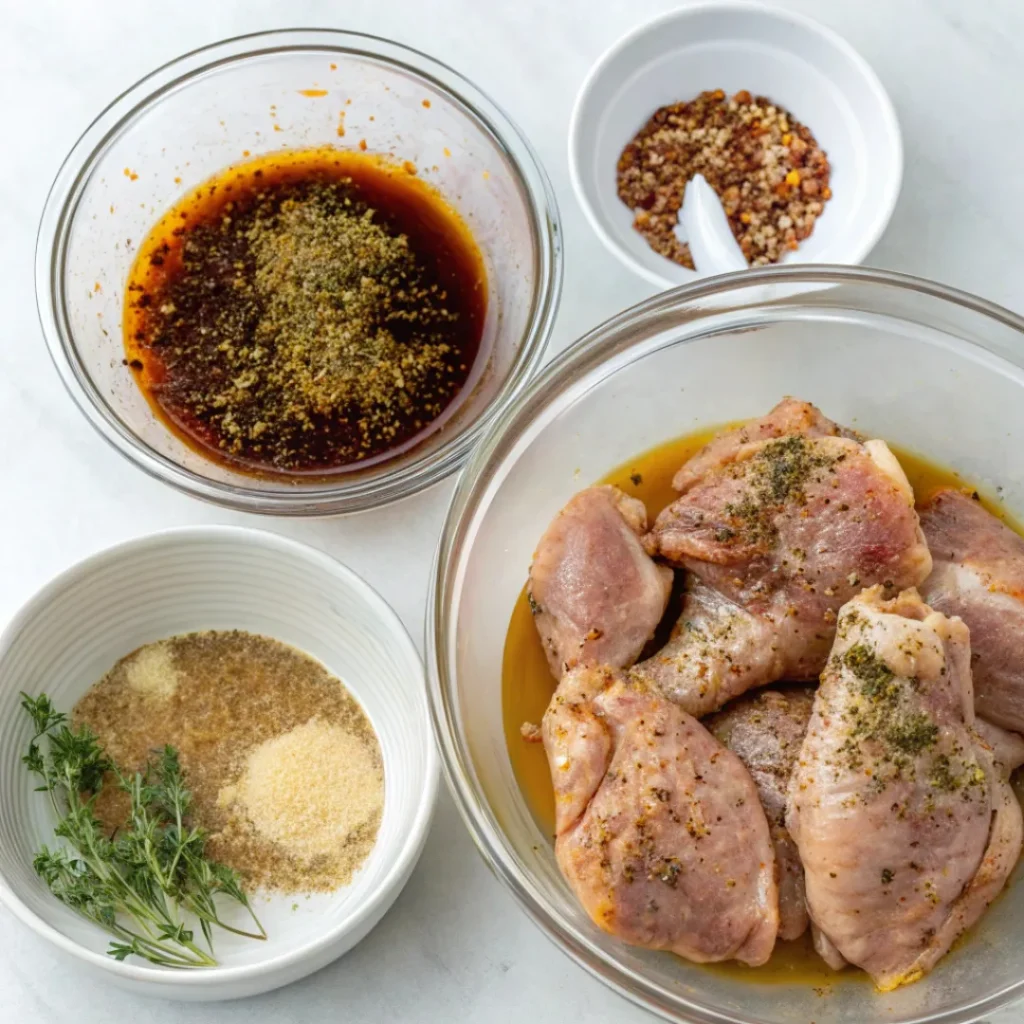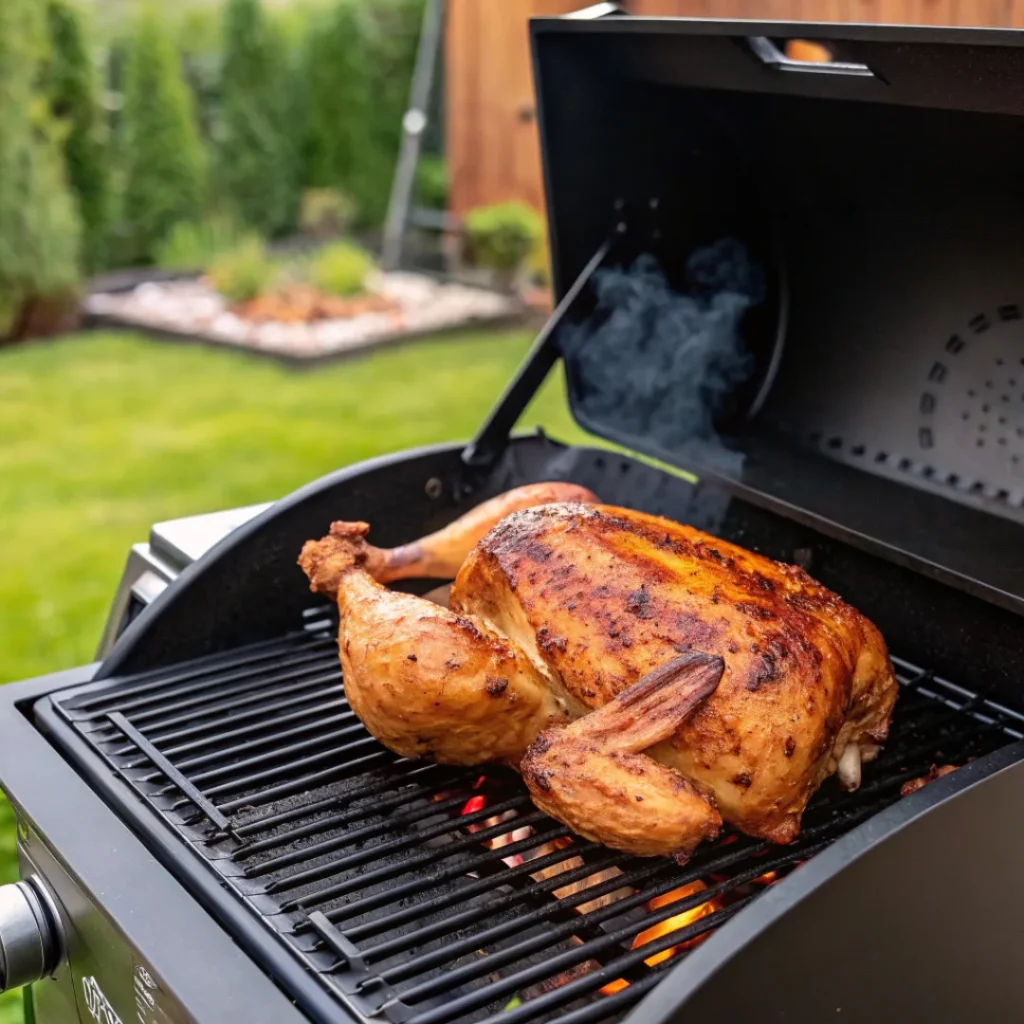Grilling chicken on a pellet grill is a delightful way to achieve a smoky, flavorful meal. However, knowing how long to grill chicken at 400 on a pellet grill is crucial to ensuring the chicken is juicy and cooked to perfection. Whether you’re a grilling enthusiast or a beginner, understanding the timing at this specific temperature is essential for achieving that perfect cook every time. The art of grilling, especially when it involves chicken, requires not just the right tools but also a keen understanding of techniques, timing, and temperature management.
Understanding Pellet Grills
Pellet grills are a relatively modern innovation in the world of outdoor cooking. They combine the convenience of a gas grill with the flavor-enhancing qualities of a charcoal grill, thanks to their use of wood pellets. These pellets come in various wood types, such as hickory, cherry, apple, and mesquite, allowing you to infuse your chicken with a specific smoky flavor that complements its natural taste.
Unlike traditional grills that may require constant monitoring and adjustment, pellet grills operate with a high level of automation. You set the temperature, and the grill does the rest, feeding pellets into the firebox as needed to maintain consistent heat. This level of precision makes it much easier to achieve perfect results every time, even if you’re not a seasoned grill master.
Benefits of Using a Pellet Grill
Even Cooking
Pellet grills maintain a consistent temperature, ensuring that your chicken cooks evenly, which is key when determining how long to grill chicken at 400 on a pellet grill.
Moisture Retention
The indirect heat from a pellet grill helps to retain the moisture in the chicken, preventing it from drying out. This is particularly important when considering how long to grill chicken at 400 on a pellet grill for different cuts of chicken.
Enhanced Flavor
The wood pellets infuse a subtle smoky flavor that enhances the overall taste of the chicken, which is an added benefit when you know how long to grill chicken at 400 on a pellet grill.
Using a pellet grill also allows for more precise temperature control, which is critical when grilling chicken. Whether you’re grilling chicken breasts, thighs, or drumsticks, maintaining a steady temperature of 400°F is key to achieving optimal results, especially when determining how long to grill chicken at 400°F on a pellet grill.
Preparation Before Grilling

Before you even fire up the grill, preparation is crucial. Proper preparation ensures that your chicken will cook evenly and absorb all the flavors from any seasonings or marinades. The preparation stage is also where you can start building layers of flavor that will make your grilled chicken truly stand out. If you’re interested in learning more about the science behind marinating meat, check out this article from Serious Eats.
Choosing the Right Chicken Cuts
When it comes to grilling chicken on a pellet grill, you have several cuts to choose from. Each cut has its own cooking time and requires slightly different handling. Understanding the characteristics of each cut will help you choose the best one for your grilling session.
Chicken Breasts
The most popular cut, known for its lean texture. Chicken breasts are a staple in many households due to their versatility and mild flavor. However, their low fat content means they can easily dry out if not cooked properly. When grilling chicken breasts, it’s important to monitor the internal temperature closely and avoid overcooking.
Thighs
Darker meat that is slightly fattier and more flavorful. Chicken thighs are often preferred by those who enjoy a richer, more succulent taste. The extra fat in chicken thighs makes them more forgiving on the grill, as they are less likely to dry out compared to breasts. Thighs also absorb marinades and rubs well, making them a great choice for flavorful grilling.
Wings
Quick to cook and ideal for appetizers. Chicken wings are a favorite at gatherings and barbecues. They cook quickly and can be seasoned in a variety of ways, from classic buffalo sauce to sweet and spicy glazes. When grilling wings, it’s important to flip them frequently to ensure they cook evenly and develop a crispy skin.
Drumsticks
Juicy and perfect for a crowd. Drumsticks are a great option for feeding a crowd, as they are easy to handle and packed with flavor. The dark meat of the drumstick stays moist during grilling, and the skin crisps up beautifully. Drumsticks can be cooked with simple seasonings or marinated for extra flavor.
The Importance of Uniformity in Chicken Pieces
When grilling chicken, especially when cooking multiple pieces at once, uniformity is key. Try to choose chicken pieces that are similar in size and thickness. This ensures that all the pieces cook at the same rate, avoiding the scenario where some pieces are undercooked while others are overdone. If you have larger pieces, consider pounding them to an even thickness or cutting them into smaller portions to promote even cooking.
Seasoning and Marination
Seasoning is a critical step that can make or break your grilled chicken. A well-seasoned chicken is packed with flavor and can elevate your grilling experience. Seasoning can be as simple or complex as you like, but the key is to ensure the flavors complement the natural taste of the chicken.
Simple Salt and Pepper
A classic choice that never fails. Salt and pepper may seem basic, but they are essential for enhancing the natural flavor of the chicken. The salt helps to draw out moisture, which then gets reabsorbed into the meat, making it more flavorful and juicy. Pepper adds a subtle heat that balances the saltiness.
Lemon and Herb
Adds a refreshing, zesty flavor. A combination of lemon juice, garlic, and fresh herbs like thyme, rosemary, or parsley can brighten up the flavor of grilled chicken. The acidity of the lemon helps to tenderize the meat, while the herbs add aromatic complexity. If you’re curious about what fruits pair well with lemon in your recipes, check out our guide on What Fruit Pairs Well with Lemon?
BBQ Rub
Perfect for those who love a smoky, slightly sweet taste. A good BBQ rub typically includes a mix of brown sugar, paprika, garlic powder, onion powder, and cayenne pepper. The sugar in the rub caramelizes on the grill, creating a delicious crust that contrasts with the tender meat inside. BBQ rubs are especially popular for grilling drumsticks and wings.
Marination Techniques
Marination is another way to enhance the flavor and tenderness of your chicken. Marinate the chicken for at least 30 minutes, but ideally, allow it to marinate for a few hours or overnight for deeper flavor penetration. The longer the chicken marinates, the more intense the flavor will be.

Wet Marinades
These are typically liquid-based and can include ingredients like olive oil, vinegar, soy sauce, citrus juice, and various herbs and spices. Wet marinades help to tenderize the meat while infusing it with flavor. They are particularly effective for lean cuts like chicken breasts.
Dry Rubs
Dry rubs consist of a mixture of spices and herbs that are massaged into the chicken before grilling. Unlike wet marinades, dry rubs don’t tenderize the meat, but they create a flavorful crust on the outside of the chicken during grilling. Dry rubs are excellent for cuts like thighs and drumsticks that benefit from a bit of extra texture on the outside.
Preheating the Pellet Grill
Before placing the chicken on the grill, preheat it to 400°F. This temperature is optimal for grilling chicken, as it cooks the meat thoroughly without drying it out. Preheating the grill ensures that the chicken starts cooking immediately, which helps to seal in the juices.
Preheating Tips and Tricks
Always allow your grill to preheat for about 10-15 minutes to ensure it reaches the desired temperature evenly. During this time, you can prepare your chicken by bringing it to room temperature, which helps it cook more evenly. If you place cold chicken directly on the grill, the sudden temperature change can cause the meat to seize up, leading to uneven cooking.
Additionally, consider using a grill thermometer to check that the grill is evenly heated. Pellet grills generally maintain consistent heat, but external factors like wind or ambient temperature can cause slight variations. A quick check with a thermometer can ensure that your grill is ready for perfect cooking.
How Long to Grill Chicken at 400°F?
Grilling times can vary depending on the cut of chicken you are cooking. Below is a detailed guide to help you determine how long each cut of chicken should be grilled at 400°F on a pellet grill. Remember that these times are estimates; the actual cooking time can vary depending on the size of the chicken pieces and the exact temperature of your grill.

Cooking Times for Different Chicken Cuts
Chicken Breasts
Grill for 20-30 minutes, turning halfway through the cooking time. Chicken breasts should be cooked until they reach an internal temperature of 165°F. Because breasts are lean, it’s important not to overcook them. To learn more about the ideal temperature settings, you can visit our guide on What Temperature Do You Cook Chicken Breast on a Pellet Grill?
Thighs
Grill for 25-35 minutes, ensuring the internal temperature reaches 165°F. Knowing how long to grill chicken at 400°F on a pellet grill will help ensure your thighs are cooked to perfection.
Wings
Grill for 15-20 minutes, flipping frequently to avoid burning. The short cooking time means it’s essential to understand how long to grill chicken at 400°F on a pellet grill when grilling wings.
Drumsticks
Grill for 30-40 minutes, turning occasionally to ensure even cooking. How long to grill chicken at 400°F on a pellet grill is especially important for drumsticks to ensure they are fully cooked without being dry.
Using a meat thermometer is the best way to ensure your chicken is cooked perfectly. Insert the thermometer into the thickest part of the meat, and make sure it reaches at least 165°F for safe consumption. It’s important to note that the temperature will continue to rise slightly as the chicken rests, so you can remove it from the grill when it reaches 160°F and let it rest until it reaches 165°F.
Common Mistakes to Avoid
Even seasoned grillers can make mistakes. Here are some common pitfalls to avoid when grilling chicken at 400°F on a pellet grill. These tips will help you avoid errors and ensure that your grilled chicken turns out perfectly every time.
Overcooking and Drying Out Chicken
One of the most common mistakes is overcooking the chicken, which can lead to dry, tough meat. To avoid this:
Monitor the Internal Temperature
Always use a meat thermometer to check for doneness. This is the most reliable way to ensure that your chicken is cooked to the right temperature. Remember, chicken should be cooked to an internal temperature of 165°F for safety.
Avoid Excessive Flipping
Too much flipping can cause the chicken to lose its juices. While it’s important to flip the chicken for even cooking, excessive flipping can cause the meat to dry out. Flip the chicken only once or twice during the grilling process.
Inconsistent Heat Distribution
Pellet grills are known for their consistent heat, but it’s still important to be aware of potential hot spots on the grill. To avoid uneven cooking:
Use a Thermometer
Place a grill thermometer in different areas to check for consistency. If you notice that some areas of the grill are hotter than others, you can adjust the placement of the chicken or rotate the pieces to ensure even cooking.
Rotate the Chicken
If you notice one side is cooking faster, rotate the chicken to ensure even cooking. This is especially important if you are grilling multiple pieces of chicken at once.
Not Using a Meat Thermometer
Grilling chicken without a meat thermometer is a gamble. The risk of undercooking or overcooking is high. Always rely on a thermometer to ensure your chicken is cooked to the right temperature. Even if you are an experienced griller, a meat thermometer is an essential tool for achieving perfect results.
Enhancing Flavor and Texture
While grilling at 400°F on a pellet grill already imparts a great flavor, there are additional techniques you can use to enhance the flavor and texture of your chicken. One way to elevate your grilled chicken is by experimenting with fruit pairings in your marinades or glazes. For example, if you’re using lemon in your marinade, you might want to explore how well it pairs with other fruits like blueberries. To learn more about this unique combination, visit our article on Does Lemon and Blueberry Taste Good Together?.
Frequently Asked Questions
Can You Cook Frozen Chicken on a Pellet Grill?
It’s generally recommended to thaw chicken before grilling. However, if you must cook from frozen, adjust the cooking time and monitor the internal temperature closely. Cooking frozen chicken will take longer, and there is a higher risk of uneven cooking, so it’s best to thaw the chicken beforehand if possible.
What Sides Pair Well with Grilled Chicken?
Grilled vegetables, a crisp salad, or a side of rice or quinoa are excellent choices. These sides complement the smoky flavor of grilled chicken perfectly. You can also serve grilled chicken with classic barbecue sides like coleslaw, baked beans, or cornbread.
How Do I Know If My Chicken Is Fully Cooked?
The best way to know if your chicken is fully cooked is by using a meat thermometer. Ensure the internal temperature reaches 165°F. You can also check for clear juices running from the meat and that the meat is no longer pink in the center.
How Long Should Chicken Rest After Grilling?
Allow the chicken to rest for 5-10 minutes after grilling. This resting period helps the juices to redistribute, making the chicken more flavorful. Resting also allows the meat to firm up, making it easier to slice and serve.
What Temperature Should I Use for Different Chicken Cuts?
While 400°F is a great all-around temperature for grilling chicken, some cuts may benefit from slightly lower or higher temperatures. For instance, wings can be grilled at 375°F to avoid charring, while drumsticks might benefit from a higher temperature for crispier skin.
Conclusion
Grilling chicken at 400°F on a pellet grill is a straightforward process that yields delicious results. By following the guidelines and tips outlined in this article, you can ensure that your chicken is cooked to perfection every time. Remember, preparation is key, and using the right techniques will enhance both the flavor and texture of your chicken.

